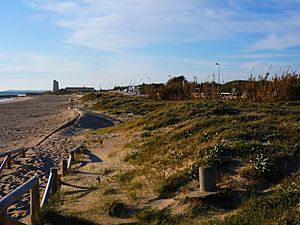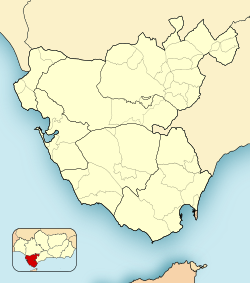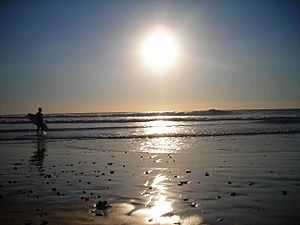El Palmar de Vejer facts for kids
Quick facts for kids
El Palmar de Vejer
|
|
|---|---|
|
Village
|
|
 |
|
| Country | |
| Autonomous community | |
| Province | Cádiz |
| Comarca | La Janda |
| Municipality | Vejer de la Frontera |
| Population
(2015)
|
|
| • Total | 909 |
| Time zone | UTC+1 (CET) |
| • Summer (DST) | UTC+2 (CEST) |
| Official language(s) | Spanish |
El Palmar de Vejer is a small village. It is part of the Vejer de la Frontera area in the Province of Cadiz, Spain. This village stretches for 8 kilometers along the Atlantic coast. It is about 11 kilometers from the main town of Vejer de la Frontera.
Contents
Geography of El Palmar
In 2015, about 909 people lived in El Palmar. It is located in the southern part of the province. You can find it between the towns of Conil de la Frontera and Zahora (which is near Barbate). El Palmar is known for growing crops like beet and wheat. It also has large green fields with palm trees where cattle graze.
History of El Palmar
El Palmar started as a small countryside area. It was surrounded by meadows that reached from the main road to the beach. Getting to El Palmar used to be quite hard. Before the A-2233 road was built, the only way from Conil was to cross a river mouth called Río Salado. This area often flooded when it rained a lot. This made it impossible for cars and animals to pass. Some buildings in the area were removed in 2018.
Economy and Tourism
The main way people in El Palmar make money is through tourism. The busiest time for visitors is in July and August. There are many restaurants along the coast. Here, tourists can enjoy local dishes. There is also a bar run by a local group called Santo Domingo de la Calzada.
Water Sports
El Palmar is very popular for water sports. Many people come here to surf, bodyboard, kite surf, paddle surf, and kayak surf. The area is often windy because it is close to the Strait of Gibraltar. These winds are perfect for these kinds of sports. The local surf waves are known for being good. They are especially great when the wind blows from the east.
The best time for surfing is in winter, from October to March. The "left waves" in El Palmar are very famous. Spanish surfers really like them. In summer, the area called La Torre is open for surfers. The rest of the beach is for people who want to sunbathe or swim. The beaches here have beautiful white, fine sand.
Local Food
The food in El Palmar mostly uses seafood. Tuna is a very important fish here. Many local restaurants and bars serve delicious dishes.
Some common dishes are:
- Tuna onion stew (a traditional local dish)
- Tuna with peas
- Salted sea bream
- Tuna flank
- Salted or grilled snapper
- Grilled swordfish
Culture and Festivals
Fun Festivals
- Carnival: Just like in the rest of Cádiz province, Carnival is celebrated in El Palmar. It happens one week after the big Carnival in Cádiz city. People enjoy dancing and costume contests.
- May Fair: This fair is all about horses. It takes place in May and lasts for four days. There are fair tents and fun rides.
- Night of San Juan: On this night, people burn figures called "Juanillos y Juanillas." Then, locals go for a swim in the sea at night. They light bonfires on the beach and spend time with friends and family.
Leisure Activities
The most popular water sports are surfing, bodyboarding, and kite surfing. Newer sports like paddle surfing and kayak surfing are also enjoyed. El Palmar is probably the best place to surf in Andalusia. This is because of its special conditions. The shape of the shore helps funnel the waves. It gets strong waves and keeps the swell for a long time.
The best conditions for surfing come from waves moving west-southwest. The best wind comes from the east-northeast. The best time to surf is from winter to spring.
Surfing Spots
The beach has different spots for surfing:
- La Torre: This old watchtower is at the north end of the village. It was used to watch for danger since the 1500s. It is also a landmark for the beach. The waves here are smaller, which is good when other areas have very big waves. The waves are clean and hollow. Even if they look small from the shore, they are powerful.
- Alferez (Roundabout, Aid Station): This central part of the beach is named after a local bar and first aid station. Surfers get more waves here than at La Torre. This spot is great when the waves are not too big. When waves are very strong, it can be hard to get into the sea. This is because of strong currents.
- El Dorado: This is the left side of the beach. It gets the biggest waves. When waves are choppy, people go to La Torre. But when the waves are smooth, El Dorado is excellent. It has very well-formed waves.
Important Landmarks
El Palmar Beach
El Palmar beach has fine, white sand. It is one of the longest beaches in the La Janda region. It is 4,200 meters long and often 80 meters wide. The water is clean and not too deep. There are no private homes right on the beach. But there are many public services. These include supermarkets, a pharmacy, restaurants, lifeguards, and a police station. There are also beach cleaning services and parking.
The beach has natural sand dunes. Special walkways have been built to protect them. Because of its improved services, El Palmar beach received a "Q" for touristic quality. This award is from the Institute of Spanish Touristic Quality.
The beach is divided into different areas. From north to south, it goes from Castilnovo beach to the Torrenueva tower. The area near the tower is usually quieter. It is often visited by families. Closer to Castilnovo, the beach becomes even calmer. Near the main entrance to El Palmar, you will find most surf schools and restaurants. In summer, this area is popular with young people, surfers, and families. The area between El Baba and Mangueta beach is very quiet. It is perfect for a relaxing walk.
Torre Almenara
The "Torre Nueva" or "Torre de El Palmar" is a famous old watchtower. It is one of the most typical towers in Cádiz province. It was built in the 1500s. Its job was to warn people about danger, especially from pirates. They used fire signals to communicate between towers. The tower was no longer used after the 1800s.
The "Torre Nueva" was built after other towers in the area. Its entrance door is a few meters high. It faces away from the shore. This made it easier to defend if attacked. In the 1900s, the tower slowly fell apart. But it has since been fixed up and looks great again.
Transport
There is a bus that connects Cádiz city with El Palmar. The bus also stops at San Fernando, Chiclana, San Andrés Golf, El Colorado, and Conil. This bus schedule has been active since September 3, 2012, from Monday to Friday.
Communications
Since 2020, El Palmar village has its own local radio station. It also has a local magazine.
Protecting the Area
Recently, there has been a discussion about a large building project near the beach. Some people want to build a big holiday resort. However, many people are against this project. They believe it would harm the beautiful natural area. They say it would ruin the natural park.
On the other side, those who support the project say it is needed for the area's economy. For a while, it seemed like the project had stopped. This was due to money problems and efforts by environmental groups. But the project was restarted in 2019.
A group called Salvarelpalmar.es has protested against the project. They have also reported their concerns to Spanish and European authorities. The area has also been named an Important Bird Area (IBA) by the Spanish Association of Ornithology (SEO). This means it is a special place for birds.
See also
 In Spanish: El Palmar de Vejer para niños
In Spanish: El Palmar de Vejer para niños






